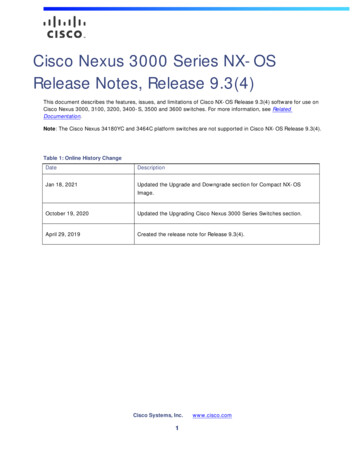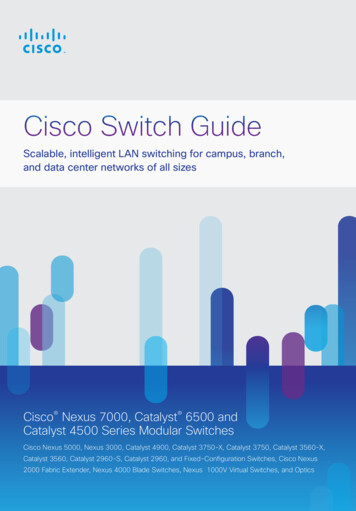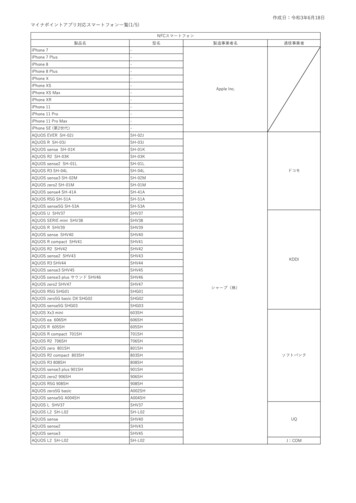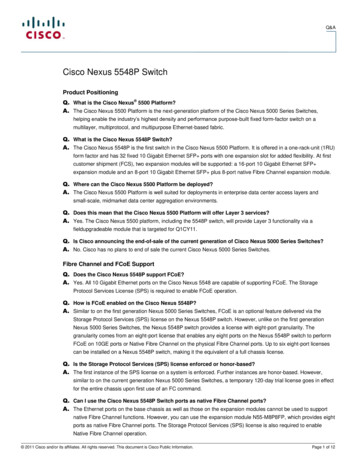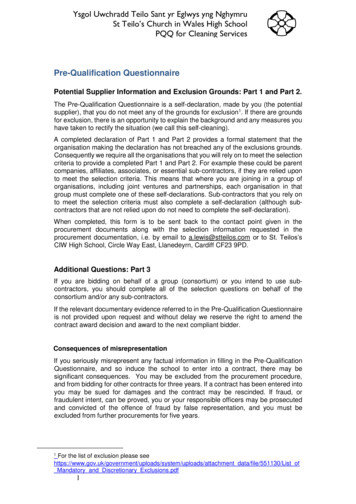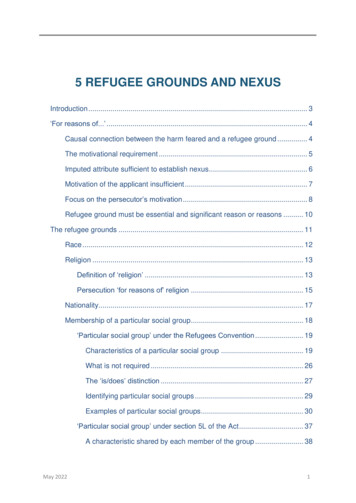
Transcription
5 REFUGEE GROUNDS AND NEXUSIntroduction . 3‘For reasons of.’ . 4Causal connection between the harm feared and a refugee ground . 4The motivational requirement . 5Imputed attribute sufficient to establish nexus . 6Motivation of the applicant insufficient . 7Focus on the persecutor’s motivation . 8Refugee ground must be essential and significant reason or reasons . 10The refugee grounds . 11Race . 12Religion . 13Definition of ‘religion’ . 13Persecution ‘for reasons of’ religion . 15Nationality. 17Membership of a particular social group . 18‘Particular social group’ under the Refugees Convention . 19Characteristics of a particular social group . 19What is not required . 26The ‘is/does’ distinction . 27Identifying particular social groups . 29Examples of particular social groups . 30‘Particular social group’ under section 5L of the Act . 37A characteristic shared by each member of the group . 38May 20221
A characteristic of a specified type . 38A characteristic that is not a fear of persecution. 40A characteristic that the applicant shares, or is perceived as sharing . 40Membership of a family as a particular social group. 40‘For reasons of . membership’ . 43Political opinion . 44‘For reasons of political opinion’ . 47Fact-finding – testing an applicant’s knowledge . 49May 20222
Refugee Grounds and Nexus5 REFUGEE GROUNDS AND NEXUS1IntroductionA protection visa applicant who has established a well-founded fear of persecution must alsoshow that the persecution is for one or more of five specified reasons. This means that therewill be persons who, despite having a well-founded fear of ‘persecution’, will not be able togain asylum as refugees.2For protection visa applications lodged prior to 16 December 2014, the reasons are thoseset out in art 1A(2) of the Convention relating to the Status of Refugees (the Convention).3For applications lodged on or after 16 December 2014, the reasons are those set out ins 5J(1)(a) of the Migration Act 1958 (Cth) (the Act).4 There is no material difference betweenthese grounds – for both definitions, the persecution must be for reasons of race, religion,nationality, particular social group or political opinion – although for post 16 December 2014applications, ‘particular social group’ has been further defined in the Act.5 Such reason orreasons must also be the essential and significant reason or reasons for the persecution.6This chapter considers the meaning of the phrase ‘for reasons of’ as interpreted byAustralian Courts and individually examines the five grounds. The case law discussed belowhas developed in consideration of art 1A(2) of the Convention, but appears equallyapplicable to the Act-based definition, with the exception of the law pertaining to ‘particularsocial group’ which is now further defined in the Act. While the Convention and Act-basedrefugee definitions refer to the same grounds, the de-linking of the Convention definitionfrom the legislative definition means that for post 16 December applications, these are nolonger properly referred to as ‘Convention grounds’, ‘Convention reasons’ or having a‘Convention nexus’. This Guide will use the phrases ‘refugee grounds’, ‘refugee reasons’ or‘refugee nexus’, other than when referring directly to the Convention context.As the element of ‘motivation’ is an essential part of both ‘persecution’ and ‘refugee nexus’,some of the issues discussed in this chapter overlap with Chapter 4 - Persecution. Issues123456Unless otherwise specified, all references to legislation are to the Migration Act 1958 (Cth) (the Act) and MigrationRegulations 1994 (Cth) (the Regulations) currently in force, and all references and hyperlinks to commentaries are tomaterials prepared by Migration and Refugee Division (MRD) Legal Services.Applicant A v MIEA (1997) 190 CLR 225 at 248.MIEA v Guo (1997) 191 CLR 559 at 570.The Migration and Maritime Powers Legislation Amendment (Resolving the Asylum Caseload Legacy) Act 2014 (Cth)(No 135 of 2014) amended s 36(2)(a) of the Act to remove reference to the Convention Relating to the Status of Refugees(the Convention) and instead refer to Australia having protection obligations in respect of a person because they are a‘refugee’. ‘Refugee’ is defined in s 5H, with related definitions and qualifications in ss 5(1) and 5J–5LA. These amendmentscommenced on 18 April 2015 and apply to protection visa applications made on or after 16 December 2014: table items 14and 22 of s 2 and item 28 of sch 5; Migration and Maritime Powers Legislation Amendment (Resolving the Asylum LegacyCaseload) Commencement Proclamation dated 16 April 2015 (FRLI F2015L00543).The Explanatory Memorandum to the Bill states that the grounds in s 5J(1)(a) are consistent with and codify those listed inthe Convention: Explanatory Memorandum, Migration and Maritime Powers Legislation Amendment (Resolving the AsylumCaseload Legacy) Bill 2014 (Cth), (pp.10 and 171).As per s 91R(1)(a) for pre-16 December 2014 applications and s 5J(4)(a) for applications made on or after that date.May 20223
Refugee Grounds and Nexusthat commonly arise when considering this aspect of the definitions are also discussed inChapter 11 – Application of the Refugees Convention in particular situations.‘For reasons of.’Causal connection between the harm feared and a refugee groundThe composite term ‘being persecuted for reasons of.’, in art 1A(2) of the Convention ands 5J(1)(a) of the Act, involves two elements; persecution, and acausal connection to therelevant characteristic of the person being persecuted.7 Determining the relevant causalconnection may be difficult and involve the assessment of a number of factors. However, it iswell established that a bare causal connection between the harm feared and a refugeeground is not enough.8 It is also not correct to rely solely upon a ‘but for’ test in determiningwhether or not the refugee nexus is made out:Questions of causal connection in the law have been described as ultimately a matter of commonsensenot susceptible of reduction to a satisfactory formula.Mere application of a ‘but for’ test to satisfy theconnection could take the scope of the Convention protection well beyond that which it was intended tosecure.9Justice Kirby observed in Chen Shi Hai v MIMA that the meaning of any statutory notion ofcausation depends upon the precise context in which the issue is presented, however:In the context of the expression “for reasons of” in the Convention, it is neither practicable nor desirable toattempt to formulate “rules” or “principles” which can be substituted for the Convention language.In the end it is necessary for the decision-maker to return to the broad expression of the Convention,avoiding the siren song of those who would offer suggested verbal equivalents. The decision-maker mustevaluate the postulated connexion between the asserted fear of persecution and the ground suggested togive rise to that fear. The decision-maker must keep in mind the broad policy of the Convention and theinescapable fact that he or she is obliged to perform a task of classification.10Courts in other cases have commented on the relevance or otherwise of common law testsof causation. For example, in Okere v MIMA Branson J concluded that the ordinary meaningof art 1A(2), considered in the light of the context, object and purpose of the Convention,invites the identification of the ‘true reason’ for the persecution which is feared, by theapplication of ‘common sense to the facts of each case’.117891011Chen Shi Hai by his next friend Chen Ren Bing v MIMA (Federal Court of Australia, French J, 5 June 1998) at 9.Chen Shi Hai by his next friend Chen Ren Bing v MIMA (Federal Court of Australia, French J, 5 June 1998) at 8–10. Seealso for example Jahazi v MIEA (1995) 61 FCR 293, where French J held at 299–300 that the question whether a particularcausal connection between persecution and membership of a group attracts Convention protection will be resolved notmerely by the logic of causality but as a matter of evaluation which has regard to the policy of the Convention.Chen Shi Hai by his next friend Chen Ren Bing v MIMA (Federal Court of Australia, French J, 5 June 1998) at 9. See alsoMIMA v Chen Shi Hai (1999) 92 FCR 333 at 342. The ‘but for’ test is a test of causation developed in torts law innegligence matters to help identify responsibility. In very basic terms it represents the question: ‘but for Event A occurringwould Event B have occurred?’.Chen Shi Hai v MIMA (2000) 201 CLR 293 at [68]–[69].Okere v MIMA (1998) 87 FCR 112 at 117–8. See also for example Gersten v MIMA [1999] FCA 1768; Peiris v MIMA [1999]FCA 880; Hellman v MIMA [2000] FCA 645; MIMA v Khawar (2000) 101 FCR 501; and Applicant N 403 of 2000 v MIMA[2000] FCA 1088.May 20224
Refugee Grounds and NexusThe weight of judicial authority indicates that there is no precise test for causation; it remainsfor the decision-maker to determine whether there is a relevant causal connection betweenthe harm feared by an applicant and a ground in the Convention, given the specificcircumstances of each case. In performing this task, the decision-maker should focus on thewords of the Convention definition and preferably use the language of the Conventionitself.12 The same principles would appear to apply in considering the Act-based definition.Although there is no precise test for causation in the context of either definition, it is at leastclear that in Australian law, the phrase ‘for reasons of’ involves consideration of themotivation and perception of the persecutor/s.The motivational requirementIt is well established that persecution involves an element of motivation for the infliction ofharm. In Ram v MIEA Burchett J said:Persecution involves the infliction of harm, but it implies something more: an element of an attitude on thepart of those who persecute which leads to the infliction of harm, or an element of motivation (howevertwisted) for the infliction of harm. People are persecuted for something perceived about them or attributedto them by their persecutors. . Consistently with the use of the word “persecuted”, the motivationenvisaged by the definition (apart from race, religion, nationality and political opinion) is “membership of aparticular social group”. . The link between the key word “persecuted” and the phrase descriptive of theposition of the refugee, “membership of a particular social group”, is provided by the words “for reasonsof” - the membership of the social group must provide the reason. There is thus a common thread whichlinks the expressions “persecuted”, “for reasons of”, and “membership of a particular social group”. Thatcommon thread is a motivation which is implicit in the very idea of persecution, is expressed in the phrase“for reasons of”, and fastens upon the victim's membership of a particular social group. He is persecutedbecause he belongs to that group.13Although that case concerned membership of a particular social group, the ‘common thread’to which Burchett J referred links ‘persecuted’, ‘for reasons of’ and each of the groundsspecified in the definitions.14In Applicant A v MIEA, Gummow J cited Ram with approval and added that the phrase ‘forreasons of’ serves to identify the motivation for the infliction of the persecution and theobjectives sought to be attained by it. The reason for the persecution must be found in thesingling out of one or more of five attributes, namely race, religion, nationality, membershipof a particular social group or political opinion.15 In MIMA v Haji Ibrahim McHugh J similarlyemphasised that the Convention requires the decision-maker to ascertain the motivation forthe allegedly persecutory conduct which an applicant for refugee status fears.161213141516Chen Shi Hai v MIMA (2000) 201 CLR 293 at [69]; Gersten v MIMA [2000] FCA 855 at [23]; WAAJ v MIMIA [2002] FCAFC409 at [24].Ram v MIEA (1995) 57 FCR 565 at 568. Approved in Applicant A v MIEA (1997) 190 CLR 225 at 284.Chen Shi Hai v MIMA (2000) 201 CLR 293 at [12] and [24].Applicant A v MIEA (1997) 190 CLR 225 at 284.MIMA v Haji Ibrahim (2000) 204 CLR 1 at [102]. To identify a motivation is to identify a reason; persecution will beConvention-related if it is Convention-motivated or stimulated: see WZARG v MIAC [2013] FMCA 69 at [41] in which theCourt rejected a submission that the Reviewer was distracted by concepts of motivation rather than looking for the reasonsfor the persecution.May 20225
Refugee Grounds and NexusIn the context of art 1A(2), the relevant nexus can be satisfied by either the discriminatorymotivation of the perpetrators of the harm or the discriminatory failure of state protection.Where the immediate harm appears to have no Convention nexus, then depending on theevidence and claims advanced by the applicant, it may be necessary to consider whetherthere is a discriminatory failure of state protection attributable to one of the five reasons.17 InMIMA v Khawar, the applicant claimed to have been subjected to domestic violence anddenied state protection because she was a woman.18 Although the judgments differed intheir characterisations of the relevant persecution, a majority of the High Court found thatsuch circumstances could come within the Convention even though the harm by the privateindividuals was unrelated to the Convention.19 If the persecution was characterised as acombination of serious harm by private individuals and a failure by the state to provideprotection against such harm, the Convention nexus requirement could be satisfied by themotivation of either the private individuals or the state.20 If the persecution was characterisedas the failure of the state to provide protection against non-Convention related domesticviolence, then the reason for the inactivity of the state must be one or more of theConvention grounds.21 However, the mere inability on the part of a state to prevent harm isnot sufficient to establish a refugee nexus. Rather, it must be shown that the failure on thepart of the state or state agents to prevent the relevant conduct is the result of toleration orcondonation of the conduct, not simply inability to prevent it.22While the above principle arose from the definition in art 1A(2) of the Convention, given thesimilar wording adopted in ss 5H(1) and 5J of the Act, it would appear equally applicable tothe statutory definition of ‘refugee’. Such an interpretation is consistent with theGovernment’s intention to codify art 1A(2) as interpreted in Australian case law.23Imputed attribute sufficient to establish nexusFor the purposes of the Convention definition and ss 5H(1) and 5J, persecution may beconstituted by the infliction of harm on the basis of perceived race, religion, nationality,17181920212223See for example DZAAZ v MIAC [2012] FMCA 39 at [122]–[129], where the Court found that the applicant had claimed onlythat the authorities were inept and unable to protect him, and had not squarely raised the issue of the absence or otherwiseof state protection for any Convention reason, and accordingly there was no error in the Reviewer failing to considerwhether there was any Convention nexus arising from a failure of state protection (upheld on appeal: DZAAZ v MIAC [2012]FCA 1128 although this point was not considered on appeal). A similar finding was made in MZYOS v MIAC [2012] FMCA422 at [60]. Contrast SZQLV v MIAC [2012] FMCA 337 at [77]–[87] where the Court found that the applicant’s claims andsubmissions and the facts accepted by the Reviewer sufficiently raised the issue that the Iraqi state may condone ortolerate the persecution that he feared from his relatives, such as to oblige the reviewer to consider whether the Iraqi statewould do so for a Convention reason. Similarly, in MZYLR v MIAC [2011] FMCA 633 the Reviewer rejected that theclaimant would need protection from the state for the reasons he claimed, but in the process of doing so, made findings thatthe roads around the town in which the applicant lived were prone to robbery and violence. The Court held at [33]–[34] and[37] that as the applicant had expressly claimed that he would be denied police protection because of his ethnicity andreligion, the Reviewer’s own findings provided a factual substratum which required consideration of that claim.MIMA v Khawar (2002) 210 CLR 1.MIMA v Khawar (2002) 210 CLR 1 at [30], [118], [85]. The majority consisted of Gleeson CJ, McHugh, Gummow and KirbyJJ, with Callinan J dissenting.MIMA v Khawar (2002) 210 CLR 1 at [31], [120].MIMA v Khawar (2002) 210 CLR 1 at [84], [87].MIAC v SZONJ (2011) 194 FCR 1 at [31]–[32].Explanatory Memorandum, Migration and Maritime Powers Legislation Amendment (Resolving the Asylum CaseloadLegacy) Bill 2014 (Cth), p.10, and 169 at [1168]. Although the Explanatory Memorandum indicates that certain principlesarising from case law were deliberately not included in the codified definition, it makes no such statement in relation to theKhawar principle, and Departmental Guidelines refer to that principle as applicable to s 5J: Department of Home Affairs,Policy: Refugee and humanitarian – Refugee Law Guidelines’, section 9.4, re-issued 1 July 2017 (Refugee LawGuidelines).May 20226
Refugee Grounds and Nexusmembership of a social group or political opinion, even if the perception is mistaken.24 AsBurchett J stated in Ram v MIEA:People are persecuted for something perceived about them or attributed to them by their persecutors.In this area, perception is important. A social group may be identified, in a particular case, by theperceptions of its persecutors rather than by the reality. The words “persecuted for reasons of” look totheir motives and attitudes, and a victim may be persecuted for reasons of race or social group, to whichthey think he belongs, even if in truth they are mistaken.25In other words, for the purposes of this aspect of the definitions, the relevant consideration isthe perception and motivation of the persecutor. A person may be at risk of persecutionbecause of a perception that he or she is a member of a particular race, religion, nationalityor social group, or holds a political opinion, even if that perception does not conform with thereality.Motivation of the applicant insufficientThe motivation of the applicant does not establish the relevant refugee nexus although itmay assist in determining the motivation of the persecutor.For example, the Federal Court has rejected the contention that punishment for illegaldeparture under Chinese laws would constitute a ground for a well-founded fear ofpersecution on the basis of political opinion if the applicants’ motivation to depart had beenbased on their own political opinion.26It has also been held that punishment for a criminal offence does not establish a wellfounded fear of persecution for reasons of political opinion merely because the offence waspolitically motivated.27In a number of other Federal Court cases, the Court has rejected the proposition that anapplicant’s subjective motivation, of itself, could support a finding that otherwise nonConvention-related harm amounted to persecution for a Convention reason.28 It has alsobeen commented that:2425262728The High Court has held that persecution may occur for perceived political opinion or perceived membership of a particularsocial group: see Chan v MIEA (1989) 169 CLR 379 at 416 at 433; Applicant A v MIEA (1997) 190 CLR 225 at 240, 284;and MIEA v Guo (1997) 191 CLR 559 at 570–1. The Full Federal Court in WALT v MIMA [2007] FCAFC 2 stated at [38]that there was no apparent reason in principle why persecution could not occur for imputed religious beliefs, as well as forimputed political beliefs or imputed membership of a particular social group. It seems clear that the same could be said forthe refugee grounds of race and nationality. The Explanatory Memorandum to the Bill which introduced ss 5H(1) and 5Jacknowledges that a Convention reason may be imputed rather than actual: Explanatory Memorandum, Migration andMaritime Powers Legislation Amendment (Resolving the Asylum Caseload Legacy) Bill 2014 (Cth), p.179 at [1221].Ram v MIEA (1995) 57 FCR 565 at 568–9.Mai Xin Lu v MIEA (Federal Court of Australia, French J, 19 July 1996) at 29–30.Welivita v MIEA (Federal Court of Australia, Lindgren J, 18 November 1996) at 21. His Honour cited paragraphs 84–86 ofthe UNHCR Handbook on Procedures and Criteria for Determining Refugee Status Under the 1951 Convention and the1967 Protocol Relating to the Status of Refugees (UNHCR, January 1992) with approval. These paragraphs remainunchanged under the current UNHCR Handbook on Procedures and Criteria for Determining Refugee Status andGuidelines on International Protection (UNHCR, reissued February 2019) (Handbook).Mehenni v MIMA [1999] FCA 789 at [20]–[21]. See also in Peiris v MIMA [1999] FCA 880, where the Court commented thatMay 20227
Refugee Grounds and Nexus[t]he accident that the particular political or ethnic sympathies of a person may cause him or her todisobey a law of general application, does not render the sanction for non-compliance persecution for aConvention reason.29Similarly, it has been held that it is insufficient for an applicant to establish that there is a fearof harm and a Convention reason (namely their political opinion) to qualify as a refugee;rather, the applicant must establish that the persecutors had actual or imputed knowledge ofthe applicant’s political opinion and would exact punishment at least partly because of thatpolitical opinion.30A different view appears to have emerged in cases involving ‘conscientious objection’ tomilitary service, where the Federal Court has emphasised the motivation of theconscientious objector rather than the claimed persecutor.31 In Applicant N403 of 2000 vMIMA, Hill J stated:if the reason [conscientious objectors] did not wish to comply with the draft was their conscientiousobjection, one may ask what the real cause of their imprisonment would be. It is not difficult to arguethat in such a case the cause of the imprisonment would be the conscientious belief, which could bepolitical opinion, not merely the failure to comply with a law of general application. It is, however, essentialthat an applicant have a real, not a simulated belief.32To the extent that these cases might suggest that the applicant’s own motivation could, ofitself, found a causal connection between the harm feared and a refugee reason they appearto be contrary to the weight of Federal Court authority discussed above, and to High Courtauthority on the meaning of ‘for reasons of’ in the Convention definition.33 The same wouldappear equally applicable to the post 16 December 2014 statutory definition of refugee. Forfurther discussion of this issue, see Chapter 11 – Application of the Refugees Convention inparticular situations.Focus on the persecutor’s motivationWhile it is the motivation of the oppressor that is important, the focus will normally be on theoppressor’s perception of the asylum seeker’s race, religion, etc., and not that of theoppressor.34 However, that will not always be the case. For example, where the applicant293031323334applying a common law test of causation, (the ‘but for’ test) as suggested in Okere v MIMA (1998) 87 FCR 112, wouldappear to introduce into art 1A of the Convention a test which is not there.Aksahin v MIMA [2000] FCA 1570 at [25]. See also SZMKK v MIAC [2010] FCA 436 at [67]–[68], [77], where the Courtcommented that it was necessary to inquire beyond the appellant’s motivation in reporting a crime to ascertain whethersubsequent threats he received were for reasons of any religious principle or political views upheld by the appellant orrather, were owed to the persecutor’s desire for revenge on him for reporting the crime.NAEU of 2002 v MIMIA [2002] FCAFC 259 at [14]–[15]. Note that this authority would now need to be considered in light ofs 91R(1)(a) or s 5J(4)(a) of the Act.Applicant N403 of 2000 v MIMA [2000] FCA 1088 and Erduran v MIMA (2002) 122 FCR 150 (on appeal, the Full FederalCourt reversed the judgment at first instance but did not consider this issue: MIMA v VFAI of 2002 [2002] FCAFC 374.Applicant N 403 of 2000 v MIMA [2000] FCA 1088 at [23]. See also Erduran v MIMA (2002) 122 FCR 150 for a similaranalysis.In particular, Applicant A v MIEA (1997) 190 CLR 225 at 240–242, 258, 284: see SZDJQ and SZDJR v MIMIA [2006] FCA533 at [40].For example, in Applicant A v MIEA (1997) 190 CLR 225 at 257, McHugh J described persecution as ‘discrimination [of aparticular kind] that occurs because the person concerned has a particular race, religion, nationality, political opinion ormembership of a particular social group’ and as discrimination ‘directed at members of a race, religion, nationality orparticular social group or at those who hold certain political opinions’ (at 258). In Chen Shi Hai v MIMA (2000) 201 CLR 293at [34], the joint judgment cited with approval French J’s observation at first instance that ‘[t]he majority judgment inApplicant A supports the proposition that the apprehended persecution which attracts Convention protection must beMay 20228
Refugee Grounds and Nexusfeared persecution as a separated woman in a Catholic country where divorce was notpermitted, it was observed that:The Applicant is not at risk of being persecuted because of her religious beliefs. If there is any risk ofpersecution, it would be because of the religious beliefs of her supposed persecutors. Even so, theConvention does not talk of persecution for reasons of the Applicant’s religion; it merely talks ofpersecution for reasons of religion. If then, there is a real chance of Ms Cameirao being persecutedbecause of her status as a woman from a failed marriage and the persecution is attributable to religion,she would be entitled to call in aid the Convention as amended by the Protocol.35A similar analysis was adopted by the Federal Court in a case where the applicants hadignored Hindu caste rules by ‘marrying’ into a prohibited relationship.36 The Tribunal statedthat if they faced persecution, their choice of lifestyle could not ‘be characterised as anexpression of a religious belief’. The Court held that there may have been an error in thisapproach and that a well-founded fear of being persecuted for reasons of religion is notlimited to people holding a religious belief, but extends also to those persecuted becausethey do not hold a religious belief:The Convention speaks of a “well-founded fear of being persecuted for reasons of . religion .”. In myopinion, if persons are persecuted because they do not hold religious beliefs, that is as much persecutionfor reasons of religion as if somebody were persecuting them for holding a positive religious belief. TheConvention protects people in relation to the subject matter of religious belief. It does not protect believersand leave non-believers to the wolves.37In each of these cases the applicant’s case was, in effect, that they feared harm because ofconduct that offended against the religion of the alleged persecutors. A similar analysis mayalso be applicable in relation to ‘political opinion.’38 However, this approach may not apply inrelation to the other refugee grounds.393536373839motivated by the possession of the relevant Convention attributes on the part of the person or group persecuted’.Cameirao v MIMA [2000] FCA 1319 at [25].Prashar v MIMA [2001] FCA 57. On appeal to the Full Federal Court this issue was decided on other grounds: see Prasharv MIMA [2001] FCA 1119 and Prashar v MIMA (2001) 115 FCR 197.Prashar v MIMA [2001] FCA 57 at [19]. His Honour added that if there were anything in Awan v MIMA [1998] FCA 435 tothe contrary, he believed it to be clearly wrong and would not follow it. See also Hellman v MIMA [2000] FCA 645 at [26]–[27], and SCAT v MIMIA [2002] FCA 962 at [33] where the Court held that a well-founded fear could arise for reasons ofreligion if the risk of harm arose for reason of the religion of the persecutors and their disposition, by reason of their religion,towards the asylum seeker (not disturbed on appeal: SCAT v MIMIA [2003] FCAFC 80).F
will be persons who, despite having a well-founded fear of 'persecution', will not be able to gain asylum as refugees.2 For protection visa applications lodged prior to 16 December 2014, the reasons are those set out in art 1A(2) of the Convention relating to the Status of Refugees (the Convention).3
